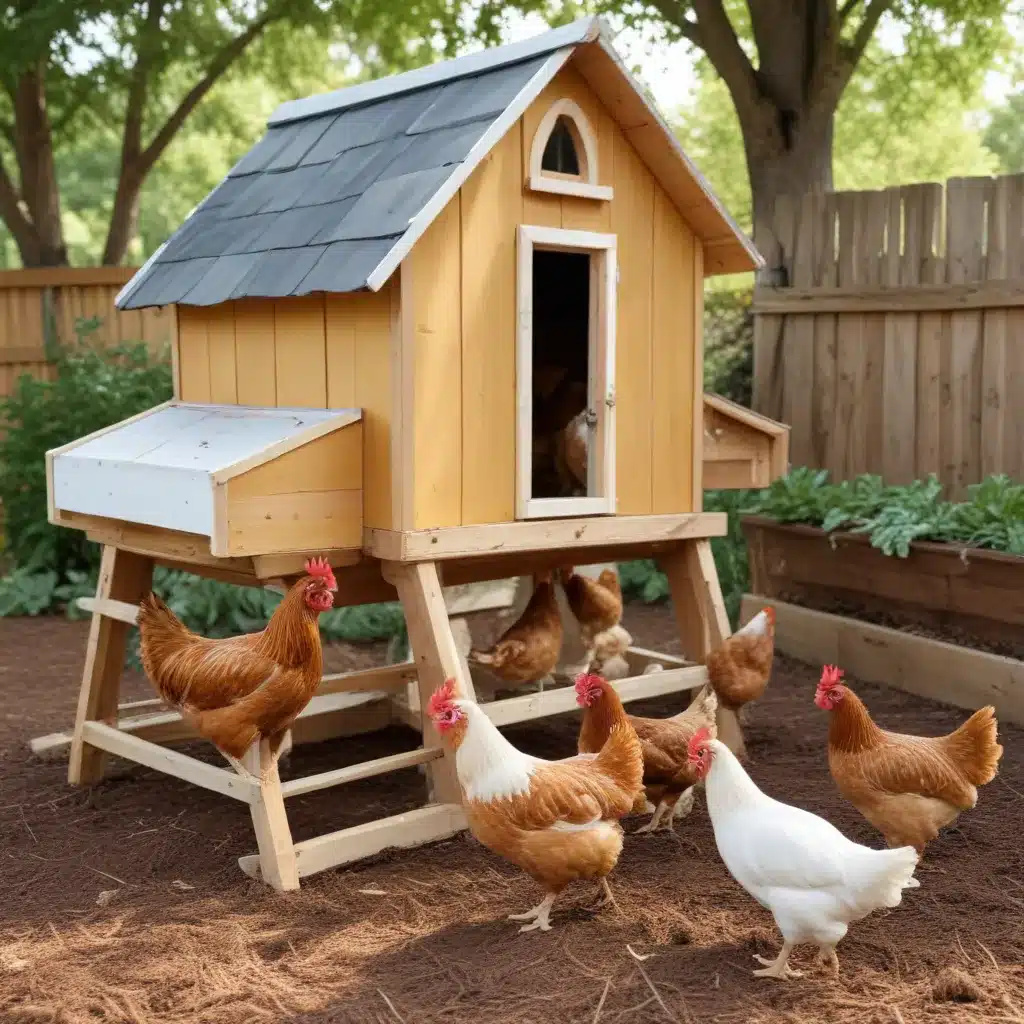
Craving the satisfaction of farm-fresh eggs and the delightful antics of a backyard flock? Raising chickens can be a rewarding experience for families of all ages. However, creating the ideal chicken coop requires careful planning and construction to ensure your feathered friends stay healthy, safe, and happy. In this comprehensive guide, we’ll explore the essential elements of designing and building the perfect backyard chicken coop.
Chicken Coop Design
The foundation of a successful chicken-keeping endeavor is a well-designed coop. Let’s dive into the key considerations for crafting the optimal living space for your flock.
Coop Dimensions and Layout
The size of your coop should be based on the number of chickens you plan to house. As a general rule, allow for a minimum of 4 square feet of floor space per standard-sized bird. Larger breeds or bantams may require slightly more or less space, respectively. Ensure the coop height allows your chickens to stand upright comfortably, with at least 2 feet of clearance above their heads.
The layout of the coop should include distinct zones for nesting, roosting, and general living space. Arrange the nesting boxes along the walls, providing one box for every 4-5 hens. Roosting bars should be positioned 12-18 inches off the ground, allowing ample space underneath for movement.
Ventilation and Insulation
Proper ventilation is crucial to maintain air quality and prevent moisture buildup in the coop. Incorporate windows, vents, or strategically placed openings to allow for cross-ventilation, while preventing drafts. Insulation, particularly in colder climates, will help regulate the temperature and protect your chickens from extreme weather.
Nesting Boxes and Roosting Perches
Provide ample nesting space, with one 12×12-inch box per 4-5 hens. Line the boxes with a soft, absorbent material like straw or shavings to encourage egg-laying. Roosting bars should be 2-4 inches off the ground and offer 8-10 inches of space per bird, allowing them to perch comfortably.
Chicken Breeds and Selection
Choosing the right chicken breed for your backyard flock is an important decision. Consider factors like egg production, temperament, and cold/heat tolerance to find the perfect fit.
Common Backyard Chicken Breeds
Some popular backyard-friendly breeds include Orpingtons, Australorps, Rhode Island Reds, Wyandottes, and Leghorns. These hens typically lay 200-300 eggs per year and are known for their calm demeanors and adaptability to various climates.
Factors to Consider in Breed Selection
In addition to egg production, think about the size of your coop and run, as well as your family’s preferences. Bantam breeds, like Silkies and Cochins, require less space but may lay fewer eggs. Larger fowl, such as Brahmas and Cochin, thrive in colder regions but need more room.
Purchasing Chicks or Pullets
When starting your flock, you can choose between baby chicks or older pullets (young hens). Chicks require more hands-on care but allow you to bond with your birds from a young age. Pullets, on the other hand, are ready to start laying eggs sooner, but may be more challenging to integrate into an established flock.
Coop Construction Materials
The materials you choose for your chicken coop can make a significant difference in its durability, longevity, and ease of maintenance.
Durable and Weather-Resistant Materials
Opt for rot-resistant woods like cedar, treated pine, or redwood for the coop frame and walls. Galvanized metal or heavy-duty plastic can be used for nesting boxes and roosting bars. Ensure the roof is weatherproof, using materials like asphalt shingles or metal roofing.
Predator-Proof Design Elements
Protect your flock from predators by incorporating metal hardware cloth or sturdy wire mesh into the coop’s design. Bury the fencing at least 1 foot underground to deter burrowing animals. Secure any entry points with heavy-duty latches or locks.
Accessibility and Easy Cleaning
Design the coop with accessibility in mind, both for your chickens and for you. Include features like removable nest boxes and drop-down roosting bars to simplify cleaning. Incorporate a deep litter system or install a removable tray to make weekly maintenance a breeze.
Coop Placement and Setup
The placement and setup of your chicken coop can have a significant impact on the health and well-being of your flock.
Site Selection and Orientation
Choose a level, well-drained location that receives partial shade and is close to a water source. Avoid areas with excessive moisture, strong winds, or heavy foot traffic. Orient the coop’s entrance to the east or south to take advantage of natural sunlight.
Fencing and Run Design
Surround your coop with a secure, predator-proof fence, burying it at least 1 foot underground. Attach the fencing to the coop itself, creating an enclosed run or outdoor space for your chickens to roam and forage. Allow for at least 10 square feet of run space per bird.
Outdoor Space and Foraging Area
In addition to the run, provide your chickens with access to a larger, fenced-off foraging area. This will allow them to explore, scratch, and engage in natural behaviors. Incorporate various textures, like dirt, gravel, and mulch, to encourage their natural foraging instincts.
Chicken Care and Management
Proper care and management are essential for the health and well-being of your backyard flock.
Daily Feeding and Watering
Invest in a feeder and waterer that are raised off the ground to prevent bedding contamination. Provide a balanced layer feed and always ensure your chickens have access to clean, fresh water. Supplement their diet with occasional treats, like scratch grains or vegetable scraps.
Egg Collection and Storage
Collect eggs from the nesting boxes daily, and store them in the refrigerator at 45°F or below. Wash the eggs with cool water and a mild detergent before storing to remove any dirt or debris.
Cleaning and Maintenance
Regularly clean the coop by removing soiled bedding and disinfecting the surfaces. Refresh the litter material, such as pine shavings or straw, weekly. Perform a thorough deep cleaning every few months to maintain a healthy, sanitary environment for your chickens.
Health and Wellness
Ensuring the health and well-being of your backyard flock is crucial for their productivity and your peace of mind.
Common Chicken Diseases and Parasites
Be on the lookout for signs of common poultry ailments, such as coccidiosis, respiratory infections, and external parasites like mites or lice. Regularly monitor your chickens’ behavior, feather condition, and droppings to identify any potential health issues.
Preventive Healthcare Measures
Implement biosecurity practices, like limiting visitor access and disinfecting equipment, to minimize the risk of disease transmission. Consider vaccinating your chickens, if recommended by your local veterinarian or poultry extension service.
Identifying and Treating Illnesses
If you suspect a health problem, consult a veterinarian experienced in poultry care. They can provide guidance on proper treatment and medication, as well as recommend preventive measures to maintain the overall health of your flock.
Regulations and Legalities
Before getting started with your backyard chicken coop, be sure to familiarize yourself with the local zoning laws and ordinances in your area.
Local Zoning and Ordinance Requirements
Many municipalities have specific regulations regarding the number of chickens allowed, coop size and placement, and even the presence of roosters. Check with your local authorities to ensure your planned setup aligns with the rules in your community.
Permits and Licensing
Some regions may require a permit or license to keep backyard chickens. Consult with your city or county officials to determine if any additional paperwork or approvals are necessary before you begin your chicken-keeping journey.
Neighbor Considerations
Be a considerate neighbor by ensuring your coop and run are located an appropriate distance from property lines and any adjacent homes. Take steps to mitigate potential noise or odor concerns, such as regular cleanings and strategic placement of the coop.
By considering these essential elements of coop design, chicken care, and legal requirements, you’ll be well on your way to creating a thriving backyard flock and enjoying the many benefits of farm-fresh eggs and the charming company of your feathered friends. For more information and inspiration, be sure to visit Crooked Pines Farm – your go-to resource for all things related to sustainable, family-friendly farming.


